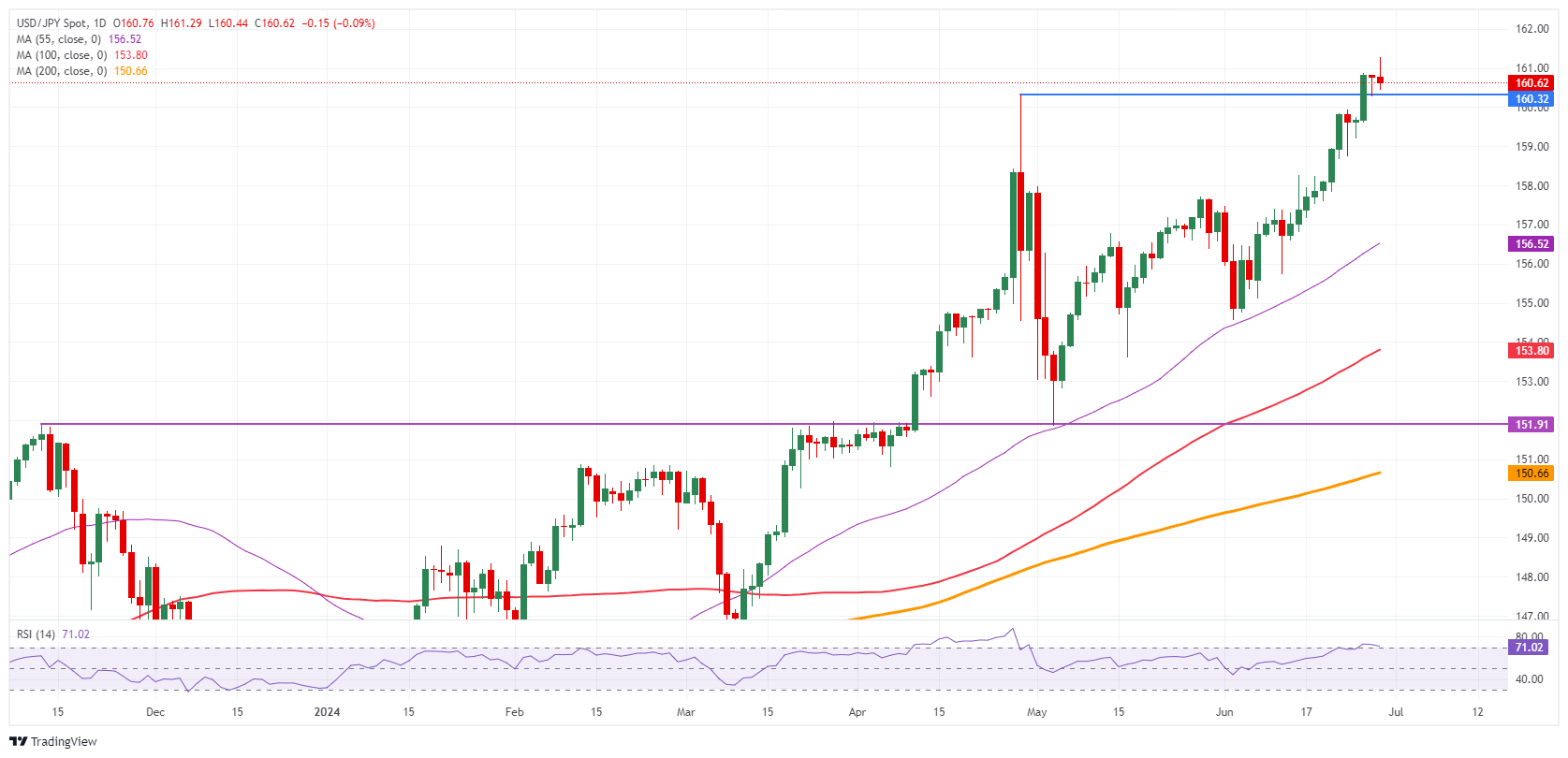- The Japanese Yen started Friday with a new multi-decade low.
- Some quick profit taking is taking place ahead of the US session and the weekend.
- The US Dollar Index is hovering around the 106.00 level again ahead of the PCE inflation release.
He Japanese yen (JPY) The move sees traders once again defying the Japanese government, with the Yen’s performance hitting a new record low. The 161.27 level was briefly touched on Friday before retreating back below 161.00. The move comes as Japanese Finance Minister Shun’ichi Suzuki repeated the same message from Thursday that the Japanese cabinet is “watching FX movements with a high sense of urgency”, which has lost its impact and sees markets defying the Ministry to take action.
Meanwhile, the US Dollar Index (DXY), which measures the value of the US Dollar against a basket of six foreign currencies, is of course in positive territory thanks to this action. Even if Thursday’s US data did not allow the US Dollar to outperform, with durable goods stagnating and pending home sales declining again for the second consecutive month. The Personal Consumption Expenditure (PCE) Price Index numbers are in line with their disinflationary trajectory and are not creating any major waves.
Daily movements and market drivers: PCE helps JPY
- At 02:30 GMT, Japanese Finance Minister Shun’ichi Suzuki commented that he is watching currency market movements with a high sense of urgency. Although this time the impact resulted in an increase in the devaluation of the Japanese Yen. The markets expected to see action this Friday, not more words and the same messages.
- At 12:30 GMT, the Personal Consumption Expenditure (PCE) Price Index data for May were released:
- The overall PCE decreased from 0.3% to 0.0%.
- Core PCE decreased slightly from 0.2% to 0.1%.
- At 13:45 GMT, the Chicago Purchasing Managers Index will be published. The number is expected to remain in contraction, from 35.4 to 40.
- At 14:00 GMT, the University of Michigan will publish the final reading for June:
- The sentiment index is expected to go from 65.6 to 65.8.
- Inflation expectations are expected to remain stable at 3.1%.
- Stocks have decided to come out strong and are showing positive numbers around the world.
- The CME Fedwatch tool broadly supports a September rate cut despite recent comments from Federal Reserve (Fed) officials. The odds now stand at 57.9% for a 25 basis point cut. A rate pause has a 35.9% probability, while a 50 basis point cut has a slim 6.2% chance.
- The overnight indexed swap curve for Japan shows a 57.9% probability of a rate hike on July 31, and a lower probability of 19.8% for a hike on September 20.
- The US 10-year bond yield is trading around the middle of this week’s range near 4.27%.
- The 10-year Japanese Treasury Note (JGB) is trading around 1.05%, and is declining slightly this week.
USD/JPY Technical Analysis: Does This Ever Work?
The USD/JPY just hit a new multi-decade all-time high on Friday. The catalyst for the move was the same one that triggered a minor rally on Thursday: the words of Japanese Finance Minister Shun’ichi Suzuki. It’s becoming clear that markets have once bought into these comments, and now they want to see action, which is pushing the Japanese government into a corner and interventions really do seem inevitable.
Although the RSI is overbought on the daily chart, a correction could still take a few more days. If the PCE data turns out to be more disinflationary, that would not be enough to push USD/JPY to 151.91. Instead, look to the 55-day Simple Moving Average (SMA) at 156.53 and the 100-day SMA at 153.81 for traders to quickly build a pivot and try to retest the highs, putting the deep Japanese pockets to the test again.
USD/JPY Daily Chart
Japanese Yen PRICE Last 7 days
The table below shows the percentage change of the Japanese Yen (JPY) against major currencies in the last 7 days. Japanese Yen was the weakest currency against the Australian Dollar.
| USD | EUR | GBP | JPY | CAD | AUD | NZD | CHF | |
|---|---|---|---|---|---|---|---|---|
| USD | 0.00% | 0.09% | 1.03% | 0.09% | -0.15% | 0.54% | 0.93% | |
| EUR | -0.01% | 0.07% | 1.03% | 0.09% | -0.13% | 0.54% | 0.91% | |
| GBP | -0.09% | -0.07% | 0.93% | 0.00% | -0.22% | 0.45% | 0.85% | |
| JPY | -1.03% | -1.03% | -0.93% | -0.93% | -1.16% | -0.49% | -0.07% | |
| CAD | -0.09% | -0.09% | 0.00% | 0.93% | -0.25% | 0.44% | 0.85% | |
| AUD | 0.15% | 0.13% | 0.22% | 1.16% | 0.25% | 0.66% | 1.08% | |
| NZD | -0.54% | -0.54% | -0.45% | 0.49% | -0.44% | -0.66% | 0.40% | |
| CHF | -0.93% | -0.91% | -0.85% | 0.07% | -0.85% | -1.08% | -0.40% |
The heat map shows percentage changes for major currencies. The base currency is selected from the left column, while the quote currency is selected from the top row. For example, if you choose the Japanese Yen from the left column and move along the horizontal line to the US Dollar, the percentage change shown in the box will represent the JPY (base)/USD (quote).
Source: Fx Street
I am Joshua Winder, a senior-level journalist and editor at World Stock Market. I specialize in covering news related to the stock market and economic trends. With more than 8 years of experience in this field, I have become an expert in financial reporting.








